Published
on 15
Jul 2014
|
All rights reserved.
|
|
|
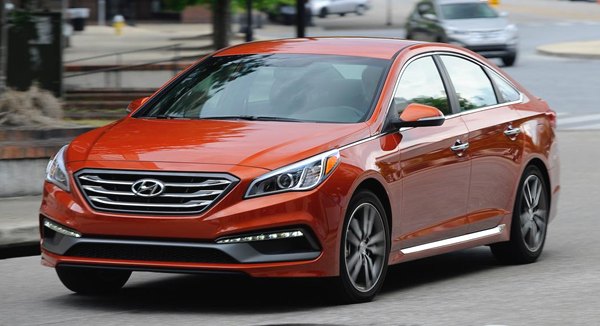 |
|
The
so-called “Fluidic Sculpture 2.0” design language adds a dose of
conservatism to please family men and women...
|
|
Hyundai Sonata has
been around for 30 years and across 6 generations. For most of the time
it was seen as a budget choice only, but recently it got stronger and
stronger following the rise of Korean motor industry. The last
generation Sonata had an ambition to rock the establishments by its
head-turning styling (called “Fluidic Sculpture”) and efficient GDI
engines. It looked to be a winner. However, people realized soon it did
not drive as good as it looked. Mediocre ride quality and acoustic
refinement prevented it from challenging Toyota Camry, Honda Accord and
Ford Fusion in the all-important American market. Some criticized it
for looking too radical for a family car. Then it was hit by the
MPG-gate (fuel economy overrated). As a result, its sales ambition
never materialized.
For the 7th generation Sonata, Hyundai takes a more cautious approach.
The so-called “Fluidic Sculpture 2.0” design language adds a dose of
conservatism to please family men and women. This is implemented by a
more upright front grille, flatter bonnet and more chrome decorations.
It is still a handsome car, if not as emotional as Mazda 6 or as sporty
as Ford Fusion. A sloping back still distinguishes it from the camp of
Camry and Accord while contributing to a low drag coefficient of 0.27
(a small improvement from the outgoing car’s 0.28).
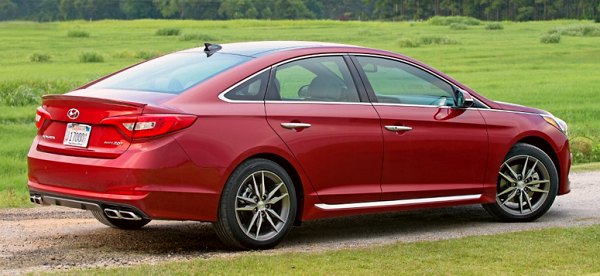 |
|
It
might have all the necessary specifications to excel in handling, but
somehow the tuning and detailed engineering are not up to the task...
|
|
More than half of the monocoque body is now made of high-strength
steel, yielding a 41 percent gain of torsional rigidity. MacPherson
struts and multi-links continue to serve in its suspensions, but now
the latter employs 2 lower links instead of one, allowing Hyundai to
fine tune its geometry to handle lateral forces better, therefore
enhances stability under braking. The mounting points of suspension
subframes have been strengthened. In addition to the stiffer chassis,
softer suspension setup can be adopted to improve ride quality without
hurting handling. Meanwhile, the front subframe employs harder bushings
to reduce slack and sharpen steering response. Speaking of steering,
the majority of new Sonata versions continue to use an electrical power
steering with column-mounted motor. Although its assistance has been
recalibrated to be more consistent, it has no hope to deliver the right
kind of feel. Instead, the range-topping 2.0 Turbo model employs a more
expensive rack-mounted dual-pinion EPS (like Volkswagen Golf and Alfa
Romeo Giulietta), no wonder it feels a lot better. Besides, the new car
also features a multi-mode driver control, with Eco, Normal and Sport
setting for you to choose and alter the characteristics of steering
weight, throttle response and gearshift pattern.
That said, no Sonatas could be described as a sporty family car in the
same breath of Ford Fusion or Mazda 6. It might have all the necessary
specifications to excel in handling, but somehow the tuning and
detailed engineering are not up to the task, even though Hyundai
unusually tested it at Nurburgring during development. There is nothing
wrong with its body control or balance, but it just isn’t as sharp to
steer or as interactive as the class best.
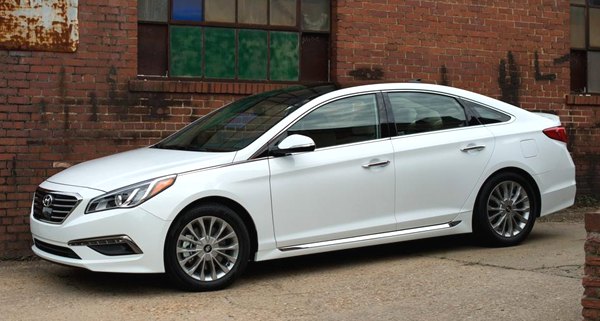 |
|
Comfortable
ride is offset by too much tire, wind and engine noise.
|
|
On the plus side, the new car does ride more comfortable than the old
one, especially when dealing with low-speed bumps. It is by no means
the most comfortable car in the class, but more than adequate for the
majority of drivers. Less improved is noise level. Although it is
already reduced, it still lags behind most competitors – remember, all
rivals are improving markedly in this respect. There is still too much
tire noise generated by the Kumho, too much wind roar produced at the
A-pillars and too much harshness can be heard from the GDI engines when
they work hard.
While this cabin is not the quietest, it is one of the largest. US EPA
measured 122 cubic feet and rated it as a large car, i.e. roughly
equals
to the European term "E-segment". Admittedly, this could be somewhat
exaggerated by the monospace shape, which adds space at locations not
benefitting passengers, i.e. under the base of windscreen and rear
window. Anyway, the rear bench of Sonata can swallow six-footers
easily, with plenty of legroom and decent headroom. Visibility is a bit
shallow though.
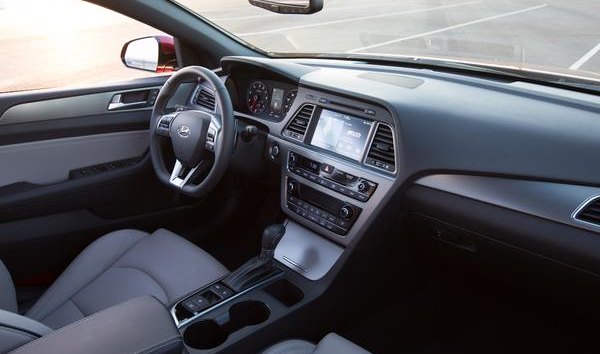
|
|
Sonata
has one of the largest cabins in the class, but the dashboard design is
nearly disastrous.
|
|
In my opinion, the new dashboard design is nearly disastrous. It is
actually a regression from the old design. While the old dash was a mix
and match of beautiful curves, the new one is flat, angular and
1980s-straightforward. It has no aesthetic to speak of. The smallish
LCD screen and air vents do not fit well into the center console and
look as if they are taken straight from another car. Likewise, the
plain dials do not fill the large instrument pod fully, delivering an
impression of aftermarket products. Its cheapness is a sharp contrast
to high-tech TFT instrument of Chrysler 200… and this is a car designed
by the same country that builds Samsung Galaxy mobiles!
If you can overcome the interior styling, you will find out its
materials, fit and finish are actually improved considerably. There are
adequately textured soft plastics covering major surfaces. The steering
wheel looks and feels more upmarket. The center console, angled
slightly to the driver side, is more convenient to access. Just avoid
the very fake wood trim.
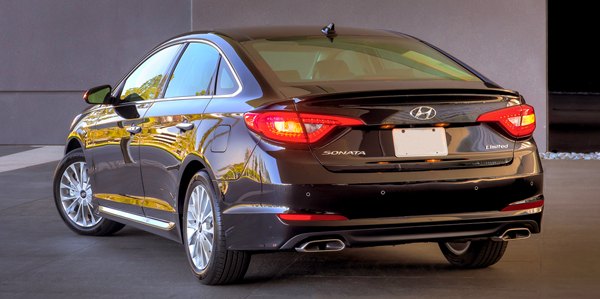 |
|
2.0GDT
engine loses 31 horsepower, so it is no longer an alternative to
Japanese V6s.
|
|
In the US market, the Sonata has a choice of 3 engines. Biggest selling
has to be the 2.4-liter GDI Theta II four-cylinder, carried over from
the last generation with minor updates. It has the hydraulic intake VVT
replaced with electrical one to extend its operation to cold start-up,
hence reducing cold-start emission. A more honest calibration resulted
in an output rating dropped from 201 to 185 hp. That might not affect
real-world performance much, but its raucous sound at high rev doesn't
change either. Sitting above the 2.4 GDI is the familiar 2.0 GDI Turbo,
now switches to a smaller twin-scroll turbo to improve low-end
response. This can be seen from its peak torque which arrives at merely
1350 rpm. On the flip side, its maximum horsepower is toned down from
274 to 245, while max. torque is reduced from 269 to 260 lbft. In the
real world it feels even less powerful, so it is no longer an
alternative to Japanese V6s. Besides, the turbo motor has to be
criticized for unrefined noise. In fact, best of the bunch is the 177
hp 1.6 GDI turbo. Similar to the marketing strategy of Ford Ecoboost,
it is priced higher than the more powerful 2.4 GDI, but in return it
gives you considerably better fuel economy, more usable performance
(thanks to more torque at lower rpm) and higher refinement. Moreover,
it is the only engine mated to the new 7-speed dual-clutch gearbox
whose gearshift quality is nearly as good as Volkswagen DSG.
Choose the 1.6T and you will find a pretty good-looking car with
adequate performance, handling and ride, plus a large cabin and
Hyundai's usual great value for money. It is not going to be a class
leader, but should be more rounded and more competitive than the last
generation. A 4-star car, just.
|
Verdict:     |
Published
on 19
Jul 2017
|
All rights reserved.
|
|
Sonata facelift 2017
|
|
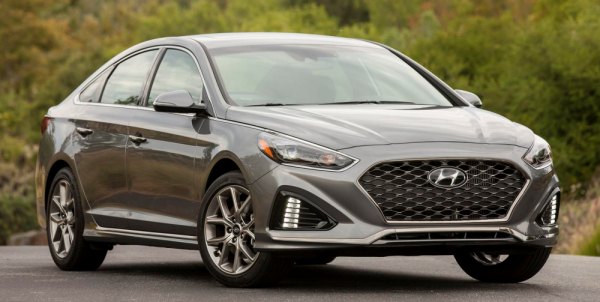
|
|
Sonata
gets a real facelift...
|
|
When the current generation
Sonata debuted 3 years ago, its styling was deliberately toned down
from its radically-styled predecessor in a bid to please average men
and women. Unfortunately, that swing was too heavy-handed, and the
market found it too conservative. The result is another few years of
slipping sales. This time Hyundai’s California studio is
responsible to give it a desperately needed facelift. Its massive mesh
front grille gives the car a much stronger presence on the street and
even a
hint of premium car. A pity the body sides are unchanged and the tail
is barely touched. In other words, this is a real facelift.
Inside, the story is more disappointing still. We used to reckon the
dashboard design too 1980s, and its fit and finish left a lot to be
desired. It deserved a full makeover in the mid-life refresh. Somehow,
Hyundai skips the request and keeps it largely the same. Only the
buttons and air vents etc. have been replaced with barely higher grade
alternatives. The outdated look and lack of quality perception remain,
so the only thing you can appreciate is the vast amount of cabin space,
which is still strong by class norm.
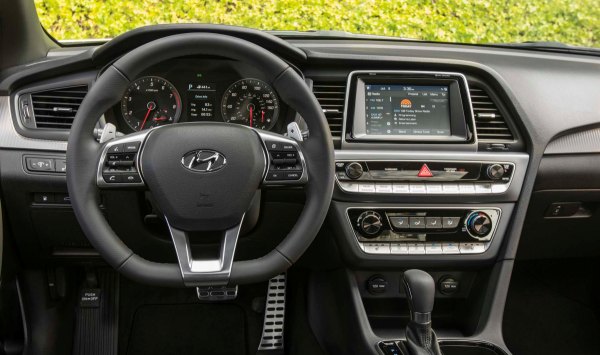
|
|
The
1980s design and lack of quality perception remains.
|
|
Changes to the mechanical aspect are equally scarce. All 3 engines
(177hp 1.6GDT, 185hp 2.4GDI and 245hp 2.0GDT) are left untouched,
although the top engine now pairs with an 8-speed automatic instead of
the last 6-speeder to enhance fuel economy by 1mpg in EPA combined
cycle. As a result, the Sonata remains a weak performer among its
rivals. The steering is said to be stiffened and retuned for better
response and more feel, but frankly, both are still not something to be
proud of. The rear suspensions get stiffer trailing arms and reworked
bushings, but the car still lacks body control. It is too softly
sprung, displaying lots of roll in corner. On the upside, the ride is
comfortable, just as before. A more premium face it might have, the
Sonata never drives like a premium car. Instead, it feels just like a
conventional Japanese or American family car, with emphasis on comfort
rather than excitement. By today’s standards, this mid-life facelift is
too thin.
|
Verdict:    |
|